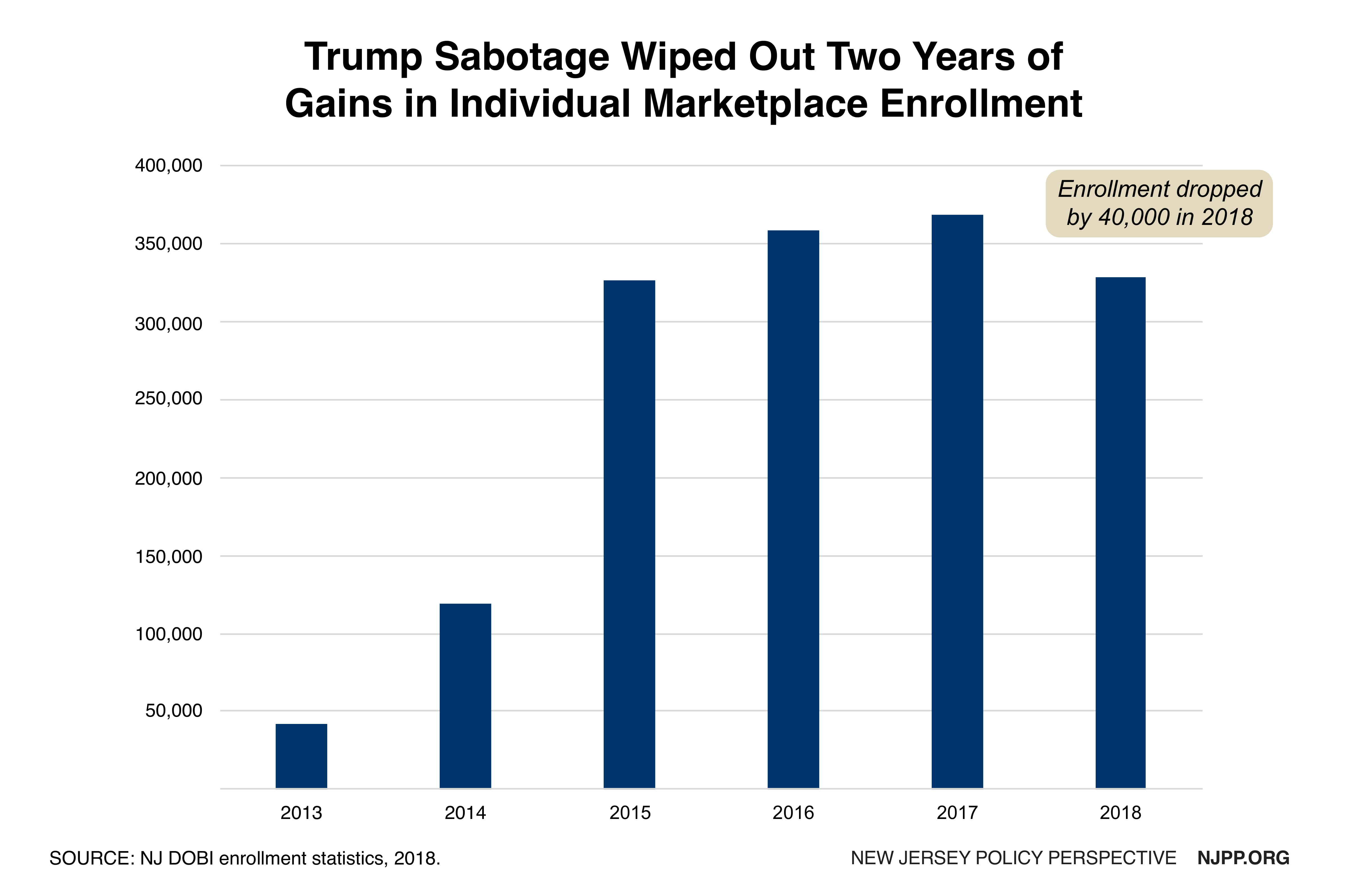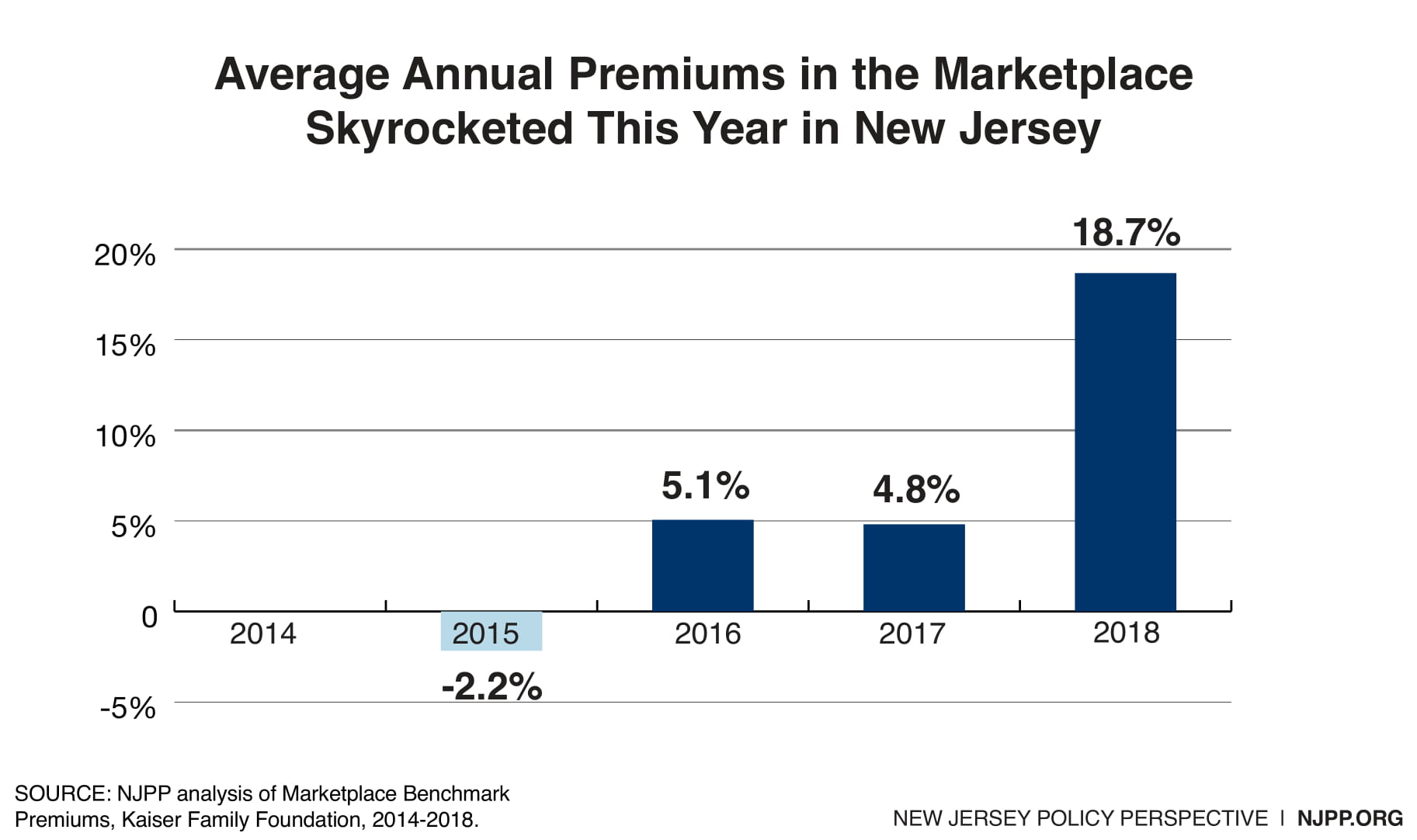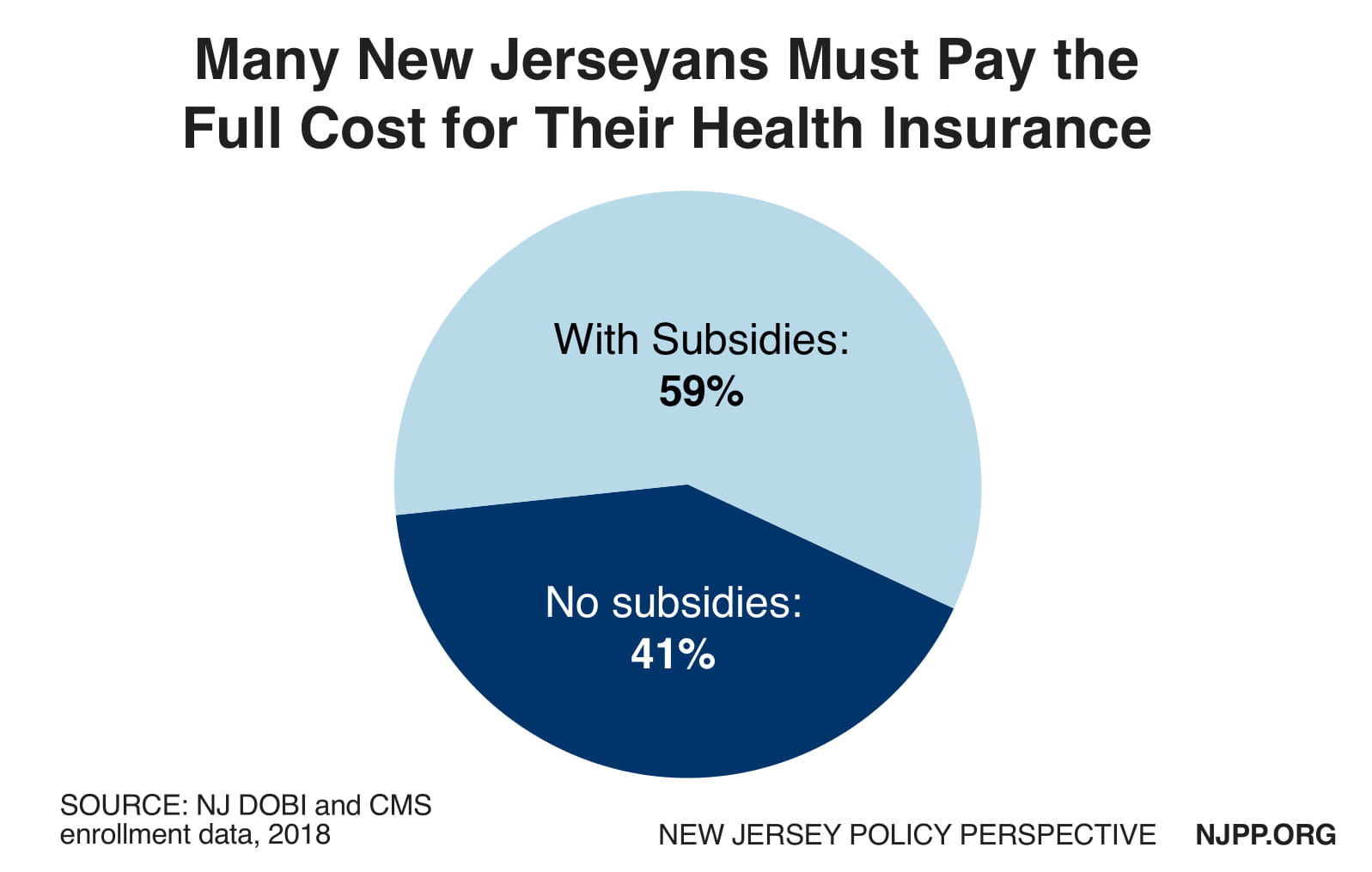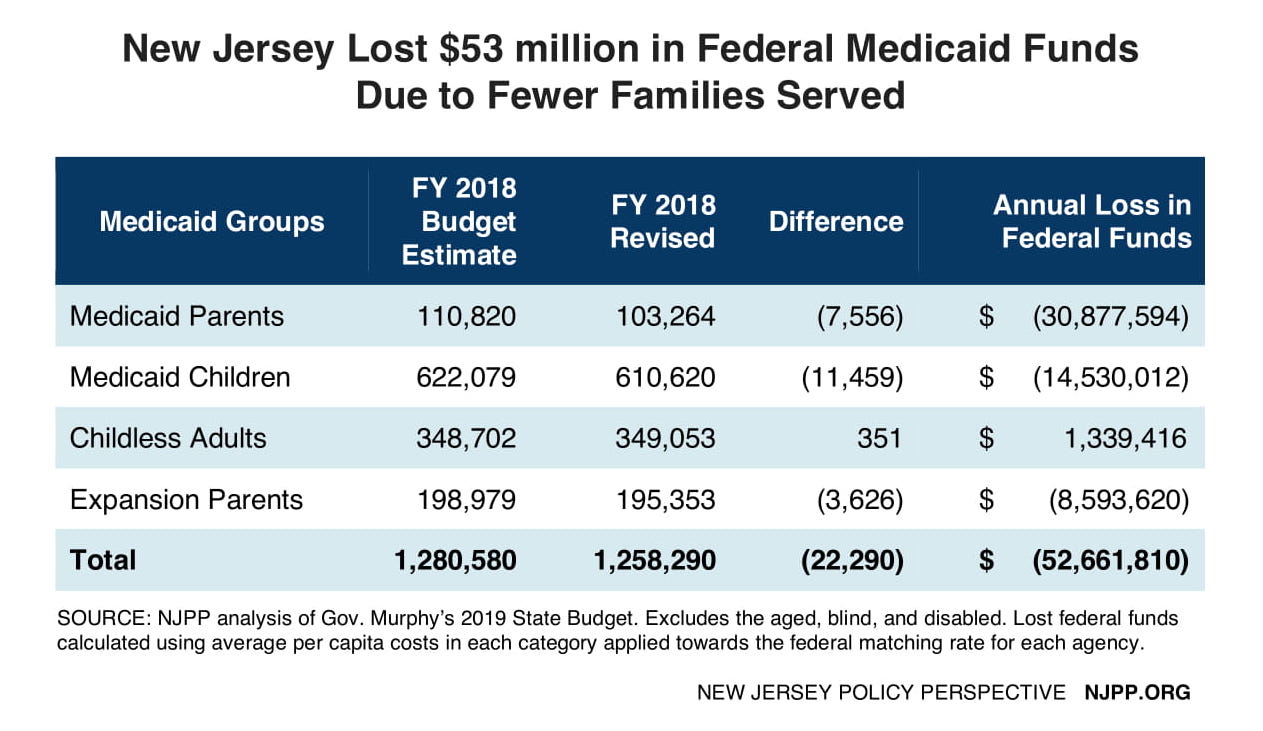To read a PDF version of this report, click here.
For a “By the Numbers” breakdown, click here.
President Trump and the Republican leadership in Congress have caused great harm to New Jersey with their efforts to undermine the Affordable Care Act (ACA). Their systematic sabotage of the health care marketplace has not only affected thousands of New Jerseyans but the economy as well. For the first time since ACA was implemented, there are decreases in both the individual market and Medicaid, which this year amounted to 62,000 fewer New Jerseyans obtaining this coverage.[1] There is also concern that the uninsurance rate in New Jersey may be increasing again. The most recent preliminary national survey found an uninsurance rate of 10.6 percent in 2016 and 11.8 percent in 2017 for ages 18-65 in New Jersey.[2]
The decrease in enrollment this year in the Marketplace and Medicaid has resulted in up to $150 million in lost federal funds in New Jersey which will affect the economy.[3] In addition, 137,000 middle class New Jerseyans who are not eligible for federal premium subsidies in the individual market paid approximately $125 million more for their insurance this year.[4] It is also estimated that there was a decrease of 22 percent in the number of Hispanics who are obtaining plans in the Marketplace due to Trump’s anti-immigrant policies.[5]
ACA Undermined in Almost Every Way Possible by Trump Administration
Congress may have been unsuccessful in their attempts to repeal and replace the ACA, but that hasn’t stopped the Trump administration from taking steps to undermine the landmark health care legislation. While it is difficult to keep track of all the attempts to undermine the ACA, the Trump administration has taken at least eighteen actions to deny health care to New Jerseyans. This includes slashing funding for navigators and advertising even though 35 percent of uninsured adults did not know about the Marketplace last year.[6] The President successfully persuaded Congress to repeal the individual mandate and eliminated cost sharing reduction payments to insurers which contributed to a spike in premiums for middle class New Jerseyans. His administration is also allowing states to sell association and junk insurance plans that do not include essential benefits that are especially needed for people with preexisting conditions. Through the Attorney General’s office, the administration is also urging a Texas court to allow states to charge higher premiums for Americans with pre-existing conditions, and the President wants to nominate a judge to the Supreme Court who would uphold such a decision.
Unprecedented Drop in Individual Market Enrollment
Enrollment in the individual market (which consists of New Jerseyans purchasing their insurance through the federal Marketplace website and those who purchase their plans directly)decreased to 329,000 from 369,000 in 2017, a drop of 39,858 New Jerseyans. This is the first decrease in enrollment since the Marketplace was established, wiping out the last two years of gains. This is especially disturbing as there are an estimated 149,000 New Jerseyans who are currently uninsured and eligible for premium subsidies.[7]
Insurance Has Become Unaffordable for Many Struggling New Jerseyans
There was a greater decrease in the enrollment rate (14 percent) this year in the off-Marketplace than there was in the Marketplace (9.6 percent) because those New Jerseyans in the off-Marketplace must pay the full cost for their premiums, whereas 80 percent of New Jerseyans in the Marketplace receive federal subsidies.[8] The income limits for subsidies – $48,240 for an individual and $98,400 for a family of four – are modest given New Jersey’s high cost of living, especially with the recent increases in premiums. The full cost of average premiums for the standard plan in the Marketplace increased 19 percent in 2018, which is seven times the average rate of the previous three years of 2.5 percent. Much of that increase was caused by the expected elimination of the individual mandate and cost sharing reduction payments.
The 137,000 New Jerseyans who did not receive subsidies paid, on average, $900 more this year in premiums for a single individual and $3,600 for a family of four compared to the average premium over the last three years.[9] Given that premiums for a family of that size were typically over $20,000 per year before the Trump administration’s sabotage of the ACA, this year’s premium increase simply made insurance unaffordable for many New Jersey families.[10]
Family Enrollment in Medicaid Decreases for the First Time
For the first time since the start of its expansion in 2014, Medicaid enrollment decreased in fiscal year 2018 for parents and children. The sabotage of the Marketplace appears to be at least one of the causes for this decrease. About one quarter of everyone who enrolls in Medicaid does so through the Marketplace even though they can apply directly.[11] Up to 140,000 of these consumers are children and parents who were already eligible for Medicaid before the ACA but were unaware until they applied for assistance in the Marketplace. This exemplifies how cutbacks in outreach and advertisement for the Marketplace also affect Medicaid enrollment.
Before the Trump administration’s efforts to sabotage the ACA, New Jersey had projected an increase in Medicaid enrollment for 2018. Instead, 14,814 fewer residents enrolled between 2018. and 2017. Taking the state’s projections into account, there were 22,290 fewer parents and kids enrolled in 2018 than was expected. As the number of unemployed New Jerseyans has remained largely flat during this period, this decrease cannot be explained by economic factors.[12]
Trumps Anti-Immigrant Policies Suppress Enrollment in Medicaid and the Marketplace
President Trump’s anti-immigrant rhetoric, federal policies, and proposals have done serious harm to Medicaid enrollment, especially in New Jersey, which has the fourth highest share of unauthorized immigrants in the nation.[13] The Trump administration’s overly aggressive actions to deport millions of unauthorized immigrants and its proposal to deny citizenship to legal immigrants if they or their child are on Medicaid discourages all legal immigrants from applying for Medicaid. This is especially true for undocumented parents who are afraid to enroll their citizen child because they fear the information will be shared with ICE and the parent will be deported. In New Jersey, one in six children have an unauthorized parent.[14] This problem is also leading to anecdotal reports that unauthorized parents are disenrolling their children in Medicaid. In 2016 there were an estimated 150,000 children covered by Medicaid/CHIP who had unauthorized parents.[15]
New Jerseyin Better Position than Most States, but Much More to Do to Achieve Universal Health Coverage
Looking into the future, New Jersey is ahead of most states in working toward universal, affordable health coverage. New Jersey already has policies in place that prohibit the sale of junk plans, and the state recently enacted legislation that restores the individual mandate and establishes a reinsurance plan that will largely offset the hike in premiums caused by the Trump administration. Governor Murphy is also formulating an outreach plan that will maximize existing state resources, although it is unclear if funding will be restored for community-based organizations to perform the same functions as navigators.
While New Jersey has taken admirable steps to defend against attacks on the ACA, the state and its congressional representatives should not lose sight of the ultimate goal to provide universal health coverage. New Jersey’s uninsured decreased by about a third due to the ACA, but there are still approximately 700,000 New Jerseyans who are uninsured, and this number may be increasing again. It will be critical that the New Jersey’s congressional delegation reverse the Trump administration’s anti-ACA actions and improve the ACA to assist more people with more affordable coverage at all income levels.
New Jersey is limited in its ability to meet this challenge by itself, but there are realistic steps it can take to reduce the uninsured in New Jersey and reversethe Trump sabotage. It can start by passing legislation to fulfill the governor’s promise to cover all the remaining uninsured kids in New Jersey. This is achievable as approximately 95 percent of all children already have health insurance. The state should also consider a state takeover of the Marketplace, so it can extend the open enrollment period and make other improvements as other state Marketplaces have done. In addition, the state will need to vigorously advertise that New Jersey has replaced the federal individual mandate with a state mandate. New Jersey will also need to tackle the biggest challenge of all: how to reduce health costs while maintaining quality and access. Recent state enactment of surprise billing legislation that also eliminates inappropriate out-of-network costs and pending bills to limit prescription drugs are good first steps Over the last six months, New Jersey has been a model for stabilizing the health insurance market, but further bold action will be necessary to combat the Trump administration’s attempts to unravel the ACA.
Endnotes
[1] Decrease in enrollment in the individual market is from New Jersey Department of Banking and Insurance website and Medicaid enrollment is calculated from the SFY 2018 governor’s budget.
[2] Robin A. Cohen, Ph.D., Emily P. Zammitti, M.P.H., and Michael E. Martinez, M.P.H., M.H.S.A, National Health Interview Survey Early Release Program, Health Insurance Coverage: Early Release of Estimates From the National Health Interview Survey, 2017, https://www.cdc.gov/nchs/data/nhis/earlyrelease/insur201805.pdf
[3] The calculations for the lost Medicaid funding are explained in the table in the report. The lost funding in the Marketplace was calculated by multiplying the average premium subsidy in 2018 by the difference in the marketplace enrolment with subsidies in 2018 and 2017. See average premiums at Kaiser Family Foundation website at https://www.kff.org/health-reform/state-indicator/marketplace-average-premiums-and-average-advanced-premium-tax-credit-aptc/?currentTimeframe=0&sortModel=%7B%22colId%22:%22Location%22,%22sort%22:%22asc%22%7D
[4] Calculated by inflating the premium in 2017 in the marketplace by the average increase over the previous three years and comparing that to what was the actual increase in 2018 multiplied by everyone who did not receive a subsidy.
[5] Karina Wagnerman, New Study Finds Evidence of a “Chilling Effect” in 2016 Marketplace Enrollment,July 19, 2018, https://ccf.georgetown.edu/2018/07/19/new-study-finds-evidence-of-a-chilling-effect-in-2016-marketplace-enrollment/
[6] Halley Cloud, In Latest Sabotage Administration Nearly Eliminates Marketplace Enrollment Assistance Funds, July 13, 2018, https://www.cbpp.org/blog/in-latest-aca-sabotage-administration-nearly-eliminates-marketplace-enrollment-assistance-funds
[7] Kaiser Family Foundation, Distribution of Non-Elderly Uninsured Individuals,https://www.kff.org/health-reform/state-indicator/distribution-of-nonelderly-uninsured-individuals-who-are-ineligible-for-financial-assistance-due-to-income-offer-of-employer-coverage-or-citizenship-status/?dataView=1¤tTimeframe=0&sortModel=%7B%22colId%22:%22Location%22,%22sort%22:%22asc%22%7D
[8] Kaiser Family Foundation, Effectuated Marketplace Enrollment and Financial Assistance, https://www.kff.org/other/state-indicator/effectuated-marketplace-enrollment-and-financial-assistance/?currentTimeframe=0&sortModel=%7B%22colId%22:%22Location%22,%22sort%22:%22asc%22%7D
[9] See note 5. Divided total increase in premiums by everyone who did not receive a subsidy.
[10] NJPP analysis of plans in Healthcare.gov for 2018.
[11] DMAHS email responding to OPRA request by NJPP, December 12, 2017. The period is December 2006 to November 2017. Through marketplace: 134,761; Direct: 277,679.
[12] NJ Department of Labor, Major Indicators of Labor Market Activity for New Jersey Seasonally Adjusted 2017 Benchmark, https://www.nj.gov/labor/forms_pdfs/lwdhome/press/2018/20180719UITABLES.pdf
[13] Pew Research Center, U.S. Unauthorized Immigration Population Estimates, November 3, 2016, http://www.pewhispanic.org/interactives/unauthorized-immigrants/ http://www.njpp.org/wp-content/uploads/2018/02/NJPPCoverAllKidsJan2018.pdf
[14] Samantha Artiga, Kaiser Family Foundation, Potential Effects of Public Charge Changes On Health Coverage For Citizen Children, March 2018, https://www.kff.org/disparities-policy/issue-brief/potential-effects-of-public-charge-changes-on-health-coverage-for-citizen-children/
[15] Ibid.






